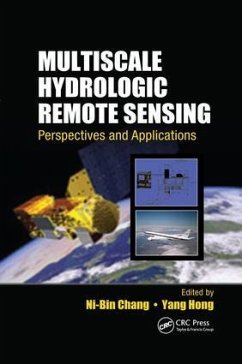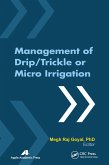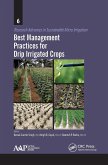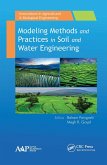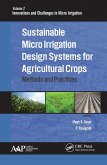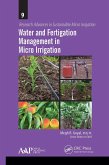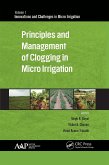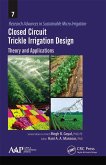Multiscale Hydrologic Remote Sensing
Perspectives and Applications
Herausgeber: Chang, Ni-Bin; Hong, Yang
Multiscale Hydrologic Remote Sensing
Perspectives and Applications
Herausgeber: Chang, Ni-Bin; Hong, Yang
- Broschiertes Buch
- Merkliste
- Auf die Merkliste
- Bewerten Bewerten
- Teilen
- Produkt teilen
- Produkterinnerung
- Produkterinnerung
Reflecting the current focus of hydrological sciences today, this color book discusses interdisciplinary issues in water resources research and remote sensing technology. It presents an exquisite arrangement of sensors, platforms, and problem-oriented features and covers all components of the hydrologic cycle, such as precipitation, soil moisture, evaporation, transpiration, lake and reservoir levels, terrestrial water storage, river discharge, and snow pack. Taking a multiscale approach, it addresses future concerns of hydrologic remote sensing under global change, including population…mehr
Andere Kunden interessierten sich auch für
![Management of Drip/Trickle or Micro Irrigation Management of Drip/Trickle or Micro Irrigation]() Megh R GoyalManagement of Drip/Trickle or Micro Irrigation112,99 €
Megh R GoyalManagement of Drip/Trickle or Micro Irrigation112,99 €![Best Management Practices for Drip Irrigated Crops Best Management Practices for Drip Irrigated Crops]() Best Management Practices for Drip Irrigated Crops112,99 €
Best Management Practices for Drip Irrigated Crops112,99 €![Modeling Methods and Practices in Soil and Water Engineering Modeling Methods and Practices in Soil and Water Engineering]() Modeling Methods and Practices in Soil and Water Engineering111,99 €
Modeling Methods and Practices in Soil and Water Engineering111,99 €![Sustainable Micro Irrigation Design Systems for Agricultural Crops Sustainable Micro Irrigation Design Systems for Agricultural Crops]() Sustainable Micro Irrigation Design Systems for Agricultural Crops112,99 €
Sustainable Micro Irrigation Design Systems for Agricultural Crops112,99 €![Water and Fertigation Management in Micro Irrigation Water and Fertigation Management in Micro Irrigation]() Water and Fertigation Management in Micro Irrigation112,99 €
Water and Fertigation Management in Micro Irrigation112,99 €![Principles and Management of Clogging in Micro Irrigation Principles and Management of Clogging in Micro Irrigation]() Principles and Management of Clogging in Micro Irrigation112,99 €
Principles and Management of Clogging in Micro Irrigation112,99 €![Closed Circuit Trickle Irrigation Design Closed Circuit Trickle Irrigation Design]() Closed Circuit Trickle Irrigation Design112,99 €
Closed Circuit Trickle Irrigation Design112,99 €-
-
-
Reflecting the current focus of hydrological sciences today, this color book discusses interdisciplinary issues in water resources research and remote sensing technology. It presents an exquisite arrangement of sensors, platforms, and problem-oriented features and covers all components of the hydrologic cycle, such as precipitation, soil moisture, evaporation, transpiration, lake and reservoir levels, terrestrial water storage, river discharge, and snow pack. Taking a multiscale approach, it addresses future concerns of hydrologic remote sensing under global change, including population growth, economic development and urbanization, and environmental degradation.
Hinweis: Dieser Artikel kann nur an eine deutsche Lieferadresse ausgeliefert werden.
Hinweis: Dieser Artikel kann nur an eine deutsche Lieferadresse ausgeliefert werden.
Produktdetails
- Produktdetails
- Verlag: CRC Press
- Seitenzahl: 568
- Erscheinungstermin: 22. November 2017
- Englisch
- Abmessung: 234mm x 155mm x 30mm
- Gewicht: 816g
- ISBN-13: 9781138072572
- ISBN-10: 1138072575
- Artikelnr.: 50856253
- Herstellerkennzeichnung
- Libri GmbH
- Europaallee 1
- 36244 Bad Hersfeld
- gpsr@libri.de
- Verlag: CRC Press
- Seitenzahl: 568
- Erscheinungstermin: 22. November 2017
- Englisch
- Abmessung: 234mm x 155mm x 30mm
- Gewicht: 816g
- ISBN-13: 9781138072572
- ISBN-10: 1138072575
- Artikelnr.: 50856253
- Herstellerkennzeichnung
- Libri GmbH
- Europaallee 1
- 36244 Bad Hersfeld
- gpsr@libri.de
Dr. Ni-Bin Chang is currently a professor with the Department of Civil, Environmental, and Construction Engineering at the University of Central Florida. He is also a senior member of the Institute of Electronics and Electrical Engineers (IEEE) and is affiliated with the IEEE Geoscience and Remote Sensing Society and the IEEE Computational Intelligence Society. He has earned the selectively awarded titles of Certificate of Leadership in Energy and Environment Design (LEED) in 2004, Board Certified Environmental Engineer (BCEE) in 2006, Diplomat of Water Resources Engineer (DWRE) in 2007, elected Member of the European Academy of Sciences (EAS) in 2008, elected Fellow of the American Society of Civil Engineers (ASCE) in 2009, and elected Fellow of the American Association for the Advancement of Science (AAAS) in 2011. He was one of the founders of International Society of Environmental Information Management and the former editor-in-chief of the Journal of Environmental Informatics. He is currently an editor, associate editor, or editorial board member of more than 30 international journals. Dr. Yang Hong is currently an associate professor with the School of Civil Engineering and Environmental Sciences and Adjunct Faculty with the School of Meteorology at the University of Oklahoma. He directs the HyDROS Lab (Hydrometeorology and Remote Sensing Laboratory) at National Weather Center and also serves as the co-director of WaTER (Water Technology for Emerging Regions) center, faculty member with the Atmospheric Radar Research Center, and affiliated member of Center for Analysis and Prediction of Storms at the University of Oklahoma. He has served as Chair of the AGU-Hydrology Section Technique Committee on Precipitation (2008-2012) and as editor for three journals. He is the recipient of the NASA Award "for significant achievements in systematically promoting and accelerating the use of NASA scientific research results for societal benefits" by NASA Headquarter Administrator in 2008. He has extensively published in journals of remote sensing, hydrology, and hazards and has released several technologies to universities, governmental agencies, and private companies.
Toward Multiscale Hydrologic Remote Sensing for Creating Integrated
Hydrologic Observatories. Local-Scale Hydrological Remote Sensing:
Advanced Ground Penetrating Radar for Soil Moisture Retrieval. Storm Impact
on the Coastal Geomorphology and Current Field by Wave Field Image
Sequences. Comparative Analysis of Surface Energy Balance Models for Actual
Evapotranspiration Estimation through Remotely Sensed Images. Thermal
Radiation and Energy Closure Assessment in Evapotranspiration Estimation
for Remote Sensing Validation. Urban-Scale Hydrological Remote Sensing:
Spatiotemporal Interactions between Soil Moisture, Vegetation Cover, and
Evapotranspiration in the Tampa Bay Urban Region, Florida. Developing a
Composite Indicator with Landsat Thematic Mapper/Enhanced Thematic Mapper
Plus Images for Drought Assessment in a Coastal Urban Region.
Watershed-Scale Hydrological Remote Sensing: Modeling Stream Flow Changes
with the Aid of Multisourced Remote Sensing Data in a Poorly Gauged
Watershed. MODIS-Based Snow Cover Products, Validation, and Hydrologic
Applications. Modeling Snowmelt Runoff under Climate Change Scenarios Using
MODIS-Based Snow Cover Products. Multispectral Satellite Data for Flood
Monitoring and Inundation Mapping. Regional-Scale Hydrological Remote
Sensing: Precipitation Estimate Using NEXRAD Ground-Based Radar Images:
Validation, Calibration, and Spatial Analysis. Radar Polarimetry for Rain
Estimation. Airborne Water Vapor Differential Absorption Lidar.
Continental- and Global-Scale Hydrological Remote Sensing: Global
Precipitation Estimation and Applications. Instantaneous Precipitation and
Latent Heating Estimation over Land from Combined Spaceborne Radar and
Microwave Radiometer Observations. Global Soil Moisture Estimation Using
Microwave Remote Sensing. Microwave Vegetation Indices from Satellite
Passive Microwave Sensors for Mapping Global Vegetation Cover. Remote
Sensing and Modeling of Global Evapotranspiration. Validation of Gravity
Recovery and Climate Experiment Data for Assessment of Terrestrial Water
Storage Variations. Remote Sensing of Soil and Vegetation Moisture from
Space for Monitoring Drought and Forest Fire Events. Index.
Hydrologic Observatories. Local-Scale Hydrological Remote Sensing:
Advanced Ground Penetrating Radar for Soil Moisture Retrieval. Storm Impact
on the Coastal Geomorphology and Current Field by Wave Field Image
Sequences. Comparative Analysis of Surface Energy Balance Models for Actual
Evapotranspiration Estimation through Remotely Sensed Images. Thermal
Radiation and Energy Closure Assessment in Evapotranspiration Estimation
for Remote Sensing Validation. Urban-Scale Hydrological Remote Sensing:
Spatiotemporal Interactions between Soil Moisture, Vegetation Cover, and
Evapotranspiration in the Tampa Bay Urban Region, Florida. Developing a
Composite Indicator with Landsat Thematic Mapper/Enhanced Thematic Mapper
Plus Images for Drought Assessment in a Coastal Urban Region.
Watershed-Scale Hydrological Remote Sensing: Modeling Stream Flow Changes
with the Aid of Multisourced Remote Sensing Data in a Poorly Gauged
Watershed. MODIS-Based Snow Cover Products, Validation, and Hydrologic
Applications. Modeling Snowmelt Runoff under Climate Change Scenarios Using
MODIS-Based Snow Cover Products. Multispectral Satellite Data for Flood
Monitoring and Inundation Mapping. Regional-Scale Hydrological Remote
Sensing: Precipitation Estimate Using NEXRAD Ground-Based Radar Images:
Validation, Calibration, and Spatial Analysis. Radar Polarimetry for Rain
Estimation. Airborne Water Vapor Differential Absorption Lidar.
Continental- and Global-Scale Hydrological Remote Sensing: Global
Precipitation Estimation and Applications. Instantaneous Precipitation and
Latent Heating Estimation over Land from Combined Spaceborne Radar and
Microwave Radiometer Observations. Global Soil Moisture Estimation Using
Microwave Remote Sensing. Microwave Vegetation Indices from Satellite
Passive Microwave Sensors for Mapping Global Vegetation Cover. Remote
Sensing and Modeling of Global Evapotranspiration. Validation of Gravity
Recovery and Climate Experiment Data for Assessment of Terrestrial Water
Storage Variations. Remote Sensing of Soil and Vegetation Moisture from
Space for Monitoring Drought and Forest Fire Events. Index.
Toward Multiscale Hydrologic Remote Sensing for Creating Integrated
Hydrologic Observatories. Local-Scale Hydrological Remote Sensing:
Advanced Ground Penetrating Radar for Soil Moisture Retrieval. Storm Impact
on the Coastal Geomorphology and Current Field by Wave Field Image
Sequences. Comparative Analysis of Surface Energy Balance Models for Actual
Evapotranspiration Estimation through Remotely Sensed Images. Thermal
Radiation and Energy Closure Assessment in Evapotranspiration Estimation
for Remote Sensing Validation. Urban-Scale Hydrological Remote Sensing:
Spatiotemporal Interactions between Soil Moisture, Vegetation Cover, and
Evapotranspiration in the Tampa Bay Urban Region, Florida. Developing a
Composite Indicator with Landsat Thematic Mapper/Enhanced Thematic Mapper
Plus Images for Drought Assessment in a Coastal Urban Region.
Watershed-Scale Hydrological Remote Sensing: Modeling Stream Flow Changes
with the Aid of Multisourced Remote Sensing Data in a Poorly Gauged
Watershed. MODIS-Based Snow Cover Products, Validation, and Hydrologic
Applications. Modeling Snowmelt Runoff under Climate Change Scenarios Using
MODIS-Based Snow Cover Products. Multispectral Satellite Data for Flood
Monitoring and Inundation Mapping. Regional-Scale Hydrological Remote
Sensing: Precipitation Estimate Using NEXRAD Ground-Based Radar Images:
Validation, Calibration, and Spatial Analysis. Radar Polarimetry for Rain
Estimation. Airborne Water Vapor Differential Absorption Lidar.
Continental- and Global-Scale Hydrological Remote Sensing: Global
Precipitation Estimation and Applications. Instantaneous Precipitation and
Latent Heating Estimation over Land from Combined Spaceborne Radar and
Microwave Radiometer Observations. Global Soil Moisture Estimation Using
Microwave Remote Sensing. Microwave Vegetation Indices from Satellite
Passive Microwave Sensors for Mapping Global Vegetation Cover. Remote
Sensing and Modeling of Global Evapotranspiration. Validation of Gravity
Recovery and Climate Experiment Data for Assessment of Terrestrial Water
Storage Variations. Remote Sensing of Soil and Vegetation Moisture from
Space for Monitoring Drought and Forest Fire Events. Index.
Hydrologic Observatories. Local-Scale Hydrological Remote Sensing:
Advanced Ground Penetrating Radar for Soil Moisture Retrieval. Storm Impact
on the Coastal Geomorphology and Current Field by Wave Field Image
Sequences. Comparative Analysis of Surface Energy Balance Models for Actual
Evapotranspiration Estimation through Remotely Sensed Images. Thermal
Radiation and Energy Closure Assessment in Evapotranspiration Estimation
for Remote Sensing Validation. Urban-Scale Hydrological Remote Sensing:
Spatiotemporal Interactions between Soil Moisture, Vegetation Cover, and
Evapotranspiration in the Tampa Bay Urban Region, Florida. Developing a
Composite Indicator with Landsat Thematic Mapper/Enhanced Thematic Mapper
Plus Images for Drought Assessment in a Coastal Urban Region.
Watershed-Scale Hydrological Remote Sensing: Modeling Stream Flow Changes
with the Aid of Multisourced Remote Sensing Data in a Poorly Gauged
Watershed. MODIS-Based Snow Cover Products, Validation, and Hydrologic
Applications. Modeling Snowmelt Runoff under Climate Change Scenarios Using
MODIS-Based Snow Cover Products. Multispectral Satellite Data for Flood
Monitoring and Inundation Mapping. Regional-Scale Hydrological Remote
Sensing: Precipitation Estimate Using NEXRAD Ground-Based Radar Images:
Validation, Calibration, and Spatial Analysis. Radar Polarimetry for Rain
Estimation. Airborne Water Vapor Differential Absorption Lidar.
Continental- and Global-Scale Hydrological Remote Sensing: Global
Precipitation Estimation and Applications. Instantaneous Precipitation and
Latent Heating Estimation over Land from Combined Spaceborne Radar and
Microwave Radiometer Observations. Global Soil Moisture Estimation Using
Microwave Remote Sensing. Microwave Vegetation Indices from Satellite
Passive Microwave Sensors for Mapping Global Vegetation Cover. Remote
Sensing and Modeling of Global Evapotranspiration. Validation of Gravity
Recovery and Climate Experiment Data for Assessment of Terrestrial Water
Storage Variations. Remote Sensing of Soil and Vegetation Moisture from
Space for Monitoring Drought and Forest Fire Events. Index.

